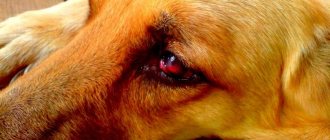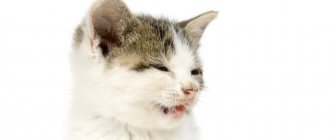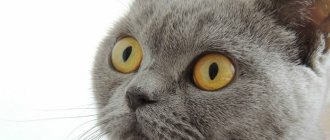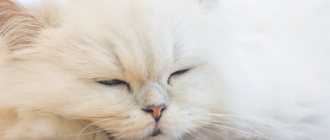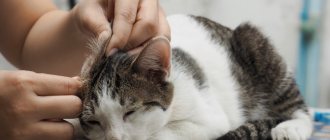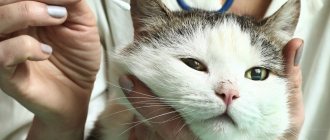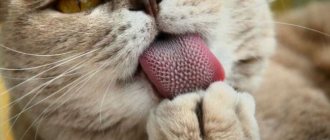Causes
A healthy kitten should have clear, clean eyes. If your pet has lacrimation, the causes of the disease may be:
- weak immunity;
- early separation from mother and inability to care for oneself;
- conjunctivitis;
- colds;
- viral infection;
- helminthic infestation (infection of a pet with parasites);
- neoplasms in the nasal cavity;
- reaction to vaccination;
- trauma, mechanical damage;
- presence of a foreign body (mote);
- allergic reaction, for example, to new food, shampoo;
- pathology of the conjunctiva and cornea;
- the breed's predisposition to eye diseases;
- blockage of the lacrimal glands.
Causes of teary eyes in cats
Involuntary lacrimation may be due to the following reasons:
- Injury. Most often, only 1 eye is damaged. The animal squints. The eye may become red. The cause of damage in most cases is a fight or accidental collision.
- Foreign body. Dust or hair may get on the mucous membranes. Most often the damage is unilateral. Sometimes a cat does not need additional treatment and copes with the problem on its own.
- Parasites. They can penetrate the eyes or release toxins into the bloodstream. Both factors provoke lacrimation.
- Allergy. The animal sneezes and scratches its skin until it bleeds. If your cat's eyes are running, you need to analyze the situation and try to identify the potential irritant. This could be food or detergent. Sometimes an allergy does not appear immediately, but after the accumulation of an irritant in the body.
- Incorrect eyelash growth. As a result of impaired development, hair can fall on the mucous membrane and irritate it.
- Cold. When a cat becomes ill, its appetite worsens, its temperature rises, and symptoms of intoxication are observed.
- Infectious diseases. Damage to the organs of vision or peripheral tissues causes irritation of the glands and the appearance of discharge.
- Inflammation. Tissues become more sensitive. The formation of a protective secretion increases.
- Strong odors. The particles irritate the mucous membranes and cause sneezing and watery eyes.
- Features of physiology. It is considered normal for a small amount of discharge to accumulate in the corners after sleep.
- Heredity. Due to anatomical features, some cat breeds (British, Sphynx, Scottish, etc.) are more prone to tearing. Due to their bulging eyes, animals react sensitively to external stimuli. Such pets require additional care, because bacteria multiply faster in a humid environment.
Breed predisposition
Breeds differ not only in appearance, but also in their predisposition to certain diseases. This does not mean that the pet will necessarily have problems, but if symptoms appear, the responsible owner should consult a doctor, bypassing the stage of self-medication.
The following cat breeds are predisposed to eye diseases:
- Persian;
- British;
- exotics (the breed was obtained artificially by crossing an American shorthair with a Persian);
- Maine Coons;
- sphinxes.
Basically, lacrimation in the listed breeds occurs due to:
- deformed nasolacrimal duct due to the structural features of the muzzle;
- inversion of the lower eyelids.
How to properly instill eye drops
A kitten's eyes are festering: how to treat it at home
So, if your pet shows signs of lacrimation, what to do and who to contact is clear. The veterinarian will diagnose the animal’s condition and select the optimal treatment. However, it must be remembered that the effectiveness of treatment of eye diseases will depend not only on correctly selected drugs, but also on their proper use.
How to properly instill eye drops
Doctors often prescribe long courses of treatment rather than one-time drug administration procedures. Correct and careful instillation of eye drops will relieve the animal of stress, which will naturally affect the results of treatment. When buying eye drops at a pharmacy, you should pay attention to the expiration date, otherwise an expired drug will not give the desired effect. The instillation process itself is not that complicated.
- First, you should sit the cat on your lap. The animal should sit with its back to the owner so that neither the tube nor the solution with napkins can be seen. Before using the drug, it is necessary to rinse (with ordinary boiled water) the eyes and the fur around the eye area. Eye treatment should be done with a cloth soaked in water or a cotton pad.
- After clearing the eye of discharge, you need to take the tube with the drug in one hand, and with your free hand, carefully open the pet’s eyelids. Apply the product into the lower eyelid, which is slightly pulled down.
- After the procedure, you need to hold the cat in your hands for a couple of minutes and make sure that it does not start rubbing or squinting its eyes. This sometimes happens because the medicated drops may cause a slight burning or itching sensation.
Associated symptoms
Watery eyes vary in severity depending on the cause.
Associated symptoms are:
- slight swelling in the eye area;
- squinting;
- sneezing, cough, runny nose;
- phlegm around the eyelids;
- hair loss, eczema;
- liquid discharge is replaced by thick;
- itching, which further injures the kitten’s eye;
- redness of the conjunctiva;
- dried marks of furrows from eye discharge;
- depressed state of the animal;
- photophobia and fever;
- brown color of discharge.
If the pet does not receive qualified veterinary care, then the symptoms only increase.
Traditional methods of treatment
Traditional methods of treatment will help get rid of discharge and alleviate the general condition of the animal, but will not eliminate the main cause of lacrimation. In folk medicine, remedies are used that are similar in composition to tears. They have a moisturizing effect and prevent strong discharge caused by eye irritation.
Important! Some cat owners recommend rinsing the animal's eyes with tea leaves. This should not be done, or you should consult a doctor before the procedure.
Traditional methods of treatment
If your pet experiences occasional seizures for which the cause is unknown, after consultation with your doctor, you can make changes to your pet's diet or include vitamin and mineral supplements. This will support the immune system during inflammation.
Mild chamomile infusions are used as an eye wash. The cooking recipe is as follows:
- Pour dry chamomile raw materials (1 teaspoon) with hot water (250 ml).
- Cover the container with a lid and leave for a quarter of an hour.
- Strain the resulting broth.
- The finished product is used to treat the eyes, soften dried particles of discharge and relieve inflammation.
Note! Before using traditional medicine, it is necessary to establish the reason why the cat’s eye is watering. In case of infection, herbal preparations and moisturizing drops will not be effective, since they do not stop the growth of bacteria.
Diagnostics in a veterinary clinic
Tearing in a kitten should not be approached as a primitive diagnosis that any animal owner can cope with.
To rule out a viral or other nature of the disease, you should contact a veterinary clinic. Self-medication will not only complicate your pet’s condition, but can also lead to blindness.
The clinic’s specialists carry out the following diagnostic activities:
- visual examination with assessment of the pet’s vision;
- general examination of appearance with an emphasis on deviations in the symmetry of the eyes, on changes in their sizes relative to each other;
- analysis of the conjunctival sac washout to determine the origin of the disease;
- examination of the eyeball, assessment of its condition;
- stool analysis if helminthic infestation is suspected (will help determine the type of parasites and prescribe an effective drug).
Diagnosis of a cat with lacrimation
To correctly diagnose a possible disease, you should observe the cat. Sometimes eye problems are accompanied by behavioral changes. Decreased activity and refusal to eat may confirm the presence of the disease. During a visual inspection it is necessary to determine:
- both eyes or only one are affected;
- how often does tearing occur?
- how much tears are produced;
- what is the purity and color of the eyeball;
- whether there are traces of blood or pus in the liquid;
- whether the mucous membranes and eyelids swell;
- Is there a prolapse of the third eyelid?
To find out the reason why your animal's lacrimation occurs, you should carefully examine the organ of vision. Before doing this, first wash your hands or wipe them with a disinfectant solution. The cat's eyes are washed to remove secretions and examined by gently pulling back the lower eyelid. Based on the diagnostic results, a clinical picture is drawn up. Signs of eye problems are determined by the condition of the visual organ and the nature of the discharge.
global $ads_google; //data-ad-slot=”2475549904″ $ads_google = empty($ads_google) ? false : true; ?> if ($ads_google == false) {?>
$ads_google = true; ?> } ?>
If a cat sneezes and tears flow
The cause of excessive tearing may be due to a bacterial, fungal or viral infection. At the same time, the cat sometimes coughs, sneezes and watery eyes. With such a problem, diseases of the respiratory system cannot be ruled out. The animal is tested for mycoplasmosis and chlamydia. With a weakened immune system, the disease can last more than a week. Another reason why a cat has watery eyes, coughing and sneezing is an allergy.
If the tears have a brown discharge
The brown color of tear fluid is due to the presence of dark-colored pigments in it. There are several reasons for this lacrimation. Some cats have brown tears because they have a short, narrow tear duct. A growing tumor can lead to a narrowing of the canal. But the anatomical structure of the organ is not always the culprit. In some cases, dark liquid accumulates due to infection of the body with worms or non-infectious inflammation of the lacrimal sac. Another reason is trauma, due to which blood enters the tear secretion.
Tears and purulent discharge
If the eyes water and pus is released, then bacterial conjunctivitis, blepharitis or keratitis is diagnosed. Sometimes the disease is aggravated by a viral infection, chlamydia. If the cat suffers from allergies, the inflammatory process is aggravated. The discharge may have a yellow, greenish, or light brown tint.
Red eyes and watery eyes
The cause of reddening of the whites with excessive tearing may be an organ injury or a foreign body getting under the eyelid. If both facts are not established during the examination, the option of allergies or increased intraocular pressure is considered. With these problems, the blood vessels often dilate and the eyes water. The cat blinks frequently, squints and avoids light.
global $ads_google; //data-ad-slot=”2475549904″ $ads_google = empty($ads_google) ? false : true; ?> if ($ads_google == false) {?>
$ads_google = true; ?> } ?>
The cat has one eye that is watery and swollen
If the problem affects only one eye, the most likely cause is mechanical damage to the organ. This could be an injury due to a blow or a sharp object getting under the eyelid. Also, the cat's eye waters and swells with unilateral conjunctivitis or glaucoma. The last problem is accompanied by a painful effect and disorientation of the pet in space. When diagnosing unilateral lacrimation and edema, it is necessary to exclude a tumor.
Tearing and cloudy eyes
If your cat's eyes are watery and cloudy, the cornea and lens need to be examined. If the color of the clouding is whitish or light blue, and the spot itself is matte, then the pathology is most likely associated with the cornea. If in the light, along with a decrease in the size of the pupil, the cloudy spot decreases, then the problem is related to the lens. Potential causes of turbidity and lacrimation are also infections, organic inclusions, scars, and vascular proliferation.
Treatment method and prognosis
Once a diagnosis is established, a course of treatment is prescribed depending on the pet’s condition.
If a kitten has a foreign body in its eye, the clinic will give an anesthetic injection to remove it, and the pet will tolerate the procedure more easily.
If ophthalmic pathologies (entropion or inversion of the eyelid) are detected, the doctor will determine the need for surgical intervention.
If the tear glands are blocked, a specialist will perform an operation to clear them.
If an infectious disease is confirmed, the doctor will add an antibiotic to the local medications.
If you visit the clinic in a timely manner, the treatment prognosis is favorable.
Causes of discharge
There are many reasons for such a deviation.
Anatomically determined lacrimation
In some cases, the cause of tearing is an anatomical predisposition. Discharge and inflammatory processes can occur due to congenital pathology of the animal. This most often affects Sphynx, Persian, British, Scottish and other exotic short-faced cats.
For your information! In a normal state, tears flow into a special nasolacrimal canal, but since the pet’s canal has some disturbances, tears flow into the periocular area.
If the cause of the obstruction is an overgrown or blocked canal, then the problem can be solved by surgical intervention. Unfortunately, surgery is not omnipotent, so there is no guarantee of a positive outcome. In addition, relapses may occur after surgery, so this type of treatment is used very rarely.
If the nasolacrimal duct is obstructed, cats may develop chronic conjunctivitis. To prevent it, it will be enough to carry out daily hygiene care using special lotions. In case of complications, the pet will require periodic antimicrobial and anti-inflammatory therapy.
Allergic reactions
Allergic reactions can occur as a result of animal contact with allergens. Signs of an allergy are frequent sneezing, wet eyes (fluid without pus or other signs of inflammation). This reaction can be triggered by cat food, contact with detergent (typical cat allergens are detergent particles dissolved in the air), medications, a vaccine or a houseplant (allergic reactions to pollen are quite rare). The simplest treatment is to eliminate the cause of the allergy.
Bacterial conjunctivitis
Conjunctivitis is a fairly common eye disease in cats. With conjunctivitis, the conjunctiva becomes inflamed. The conjunctiva is the thin mucous membrane that covers the eyeballs and the inside of the eyelids. It contains the flow channels of the lacrimal glands, which protect the cat's eye from drying out and from small foreign bodies.
Conjunctivitis in cats
Symptoms of conjunctivitis:
- lacrimation and redness of the eyes. The eyelids may swell or experience pain and discomfort when exposed to light. Eyes may change color and become cloudy;
- the movements of the eyeballs are disrupted, and the eyelids become everted.
Note! Catarrhal conjunctivitis is most often observed in cats. This is the most harmless type, which can be treated with standard methods under the supervision of a veterinarian. Characteristic signs are red eyes, swelling of the eyelid mucosa, and an inflamed eye that does not open.
With purulent conjunctivitis in cats, colored fluid begins to ooze from the eyes, and the eye may fester. At the initial stage, yellowish crusts and liquid green-yellow pus can be seen in the eye area. Lack of treatment will lead to serious complications - keratitis, panophthalmitis and blindness.
In the case of follicular conjunctivitis in cats, in addition to the mucous membrane of the eyelids, the lymphatic follicles also become inflamed. The animal will need veterinary care, and treatment may take a long period. Follicles are often removed through surgery, after which a course of treatment is prescribed.
Injury
Eye damage is a very serious problem that can lead to complete loss of vision. Therefore, in case of injury, it is necessary to urgently seek qualified help. Symptoms of eye damage are profuse lacrimation (both with and without particles of pus), unevenness on the cornea, redness of the periocular area.
Eye injuries
Age-related lacrimation (tears in kittens)
A common cause of watery eyes is age-related symptoms. Young kittens (2-8 weeks) and older cats (8 years and older) may suffer from heavy discharge in the eye area. If the secreted liquid is transparent and the animal’s eyes are not inflamed, then hygienic treatment will be sufficient. Watery eyes can also cause decreased immunity. Therefore, it is recommended to take the animal to a veterinarian for examination and determination of the cause.
Foreign object in the eye
If even a small foreign body gets into an animal's eye, serious inflammation can occur, the organ will turn red and increase in size. The fact is that microorganisms located on the surface of an object can cause the development of diseases such as keratitis, uveitis, purulent conjunctivitis, retinal hemorrhage, and also lead to loss of vision.
Important! Sometimes it happens that a particle gets into the eye and initially does not cause discomfort in the cat. But if a foreign object remains in the inner part of the eye for a long time, it provokes various inflammations, including blindness and even the need to remove the eyeball. Therefore, if a cat’s eye is watery and there is a suspicion that a foreign object has gotten into it, you should consult a veterinarian.
Parasites
The cause of the discharge may be parasites in the cat's body. Their presence is checked by analyzing the animal's feces for helminths. If a cat is found to have worms, it is necessary to deworm it.
What to do at home
When prescribing medications, it is important to observe their dosage and frequency of administration.
At home, it is necessary to ensure proper storage of medications, following the medical instructions.
If your doctor prescribes drops or ointment, then before instilling them (putting them in), you should clean your pet’s eyes of any dirt. This is done with a disinfectant or special wipes in the direction from the outer corner to the animal’s nose. A new swab (cotton swab) should be used for each eye.
The owner's hands must be clean during procedures - thoroughly washed with soap.
Prevention of tearing
The answer to the question of what to do at home to prevent tearing will be clear. It is necessary to observe the rules of hygiene, avoid irritating factors and promptly consult a doctor for help.
Do not rinse cats' eyes unless necessary. In most cases, animals wash themselves. Third-party interference can cause inhibition of natural microflora, injury to the outer membranes and infection. Many breeds do not require additional procedures. The exception is animals with bulging eyes and a short muzzle.
It is advisable to eliminate drafts, stop smoking and avoid using harsh perfumes. These factors can cause increased lacrimation in a cat and cause infection due to suppression of local immunity. The animal's diet must be balanced. It is recommended not to purchase economy or premium food, since such products are not suitable for constant feeding. It is advisable not to include exotic fruits and sweets in your diet.
If problems arise, you should immediately contact a veterinarian and undergo an examination. It is easier to fight diseases in the early stages.
All information posted on the site is provided in accordance with the User Agreement and is not a direct instruction to action. We strongly recommend that before using any product, you must obtain a face-to-face consultation at an accredited veterinary clinic.
Possible complications
If a kitten has watery eyes and refuses to go to the clinic, irreversible processes may begin in the animal’s body.
It must be remembered that dangerous viral diseases that occur with lightning speed and are destructive for a fragile pet can manifest themselves as lacrimation. A problem noticed in time can be overcome much faster and easier than an advanced severe form of the disease.
Why do Scottish Fold cats have watery eyes?
global $ads_google; //data-ad-slot=”2475549904″ $ads_google = empty($ads_google) ? false : true; ?> if ($ads_google == false) {?>
$ads_google = true; ?> } ?>
Breeders and cat lovers know that Scottish kittens and adult pets often have watery eyes. In childhood, this symptom is more pronounced than in adulthood. The anatomical structure of the head and eyes of these cats has special differences. The canal coming from the lacrimal gland is shortened, so tears do not linger in the ducts and quickly come out. The predisposition is explained by the flattened shape of the skull, which determines the non-standard structure of the ocular analyzer.
Scots' eyeballs are large, so they require regular washing with tear fluid. Otherwise, the cat is at risk of drying out the cornea. At the same time, cats that show suspicious signs must be examined, since eye diseases are no less common in them than in other breeds.
Treatment
Self-medication is dangerous for your cat's health. The wrong medications can undermine it even further by attacking the microflora of the intestines, liver and kidneys. Potassium permanganate dries out the delicate mucous membranes of the eye, leading to problems including loss of vision.
The veterinarian knows best what will help the pet. To relieve irritation, the drugs Anandin, Tsiprovet, and Iris are usually prescribed. Bars eye drops can be used as a cure for infections and as a preventative hygiene product. Albucid is often used to relieve lacrimation in a kitten, but only after a prescription from a veterinarian.
For a viral infection, the doctor will prescribe chloramphenicol or tetracycline ointment. If the cause is helminths, you need to find out from the doctor how best to carry out the treatment in this case.
A radical surgical solution is rarely prescribed, for example, if a cat has an entropion of the eyelid. However, there is no need to worry ahead of time - most often, the cause is allergies and colds. In this case, the doctor will tell you how best to carry out prevention and prescribe the vitamin supplements or anti-allergy medications needed for your pet.
Be sure to read the article about vitamin deficiency in cats, because these conditions may be related.
Cat Eye Care: Preventing Tears
In order not to have to find out the reason why your cat’s eyes are watery and not resort to treatment, it is necessary to constantly engage in the prevention of eye diseases. This is especially true for purebred kittens that have a genetic predisposition.
global $ads_google; //data-ad-slot=”2475549904″ $ads_google = empty($ads_google) ? false : true; ?> if ($ads_google == false) {?>
$ads_google = true; ?> } ?>
If your cat’s eyes water for natural reasons, then for hygienic care it is enough to periodically wash them with a physiological or disinfectant solution. In case of abundant natural discharge, the procedure is carried out twice a day: in the morning and in the evening. This hygienic treatment is suitable for the prevention of eye diseases in cats of all breeds.
The complex of preventive measures includes systematic treatment against helminths and ectoparasites. To prevent a long-haired cat from having watery eyes, she needs grooming. Long hairs can touch the eyeball and stimulate tearing. To exclude chronic diseases and infections that provoke eye diseases, the pet should be protected from hypothermia, vaccinated on time and fed with nutritious food.
All accessories and tools for processing (swabs, pipettes, syringes, containers) must be perfectly clean.
Symptoms
If a pathological cause is obvious, all manifestations of the disease should be observed to give the doctor as complete a history as possible to ensure the best decision.
Common cat diseases manifest themselves as follows:
| Symptom | Disease and cause |
| Long and profuse tearing. | Viruses and fungi such as plasmosis: calcivirosis, mycoplasmosis, toxoplasmosis, etc. |
| Pus. | Foreign objects. |
| Edema. | Turn of the century. |
| Cloudiness. | Keratitis, cataract. |
| Black spot. | Dying of the cornea. |
| Tears are accompanied by fever, diarrhea, vomiting, and lethargy. | Feline distemper (panleukopenia). |
| Swelling with cloudiness. | Glaucoma. |
| Swelling in the corners of the eye. | Inflammation of the lacrimal glands. |
| Redness of the membranes, photophobia. | Conjunctivitis. |
| Damage to one eye. | Parasites. |
Reasons for tears
If a cat’s eyes are running, only a veterinarian can tell you what to treat, since the secretion of tear fluid is a defensive reaction in response to irritants, almost all of which are due to illness:
- inflammation of the conjunctiva (this is a symptom of a pathological condition; viral conjunctivitis could be avoided by timely vaccination!);
- against the background of a cold (rinotracheitis);
- the presence of intestinal parasites (therefore it is necessary to repeat deworming every 3 months);
- allergies (to household chemicals, dust, food, animal care products, etc.);
- mechanical damage (trauma, foreign body);
- anatomical predisposition (Persians, etc.);
- infection from outside;
- eye lesions: blepharitis, keratitis, neoplasms, etc.
And this list is not complete yet. As you can see, it’s impossible to figure this out without a veterinary education. And to treat at random...
What to do if your cat's eyes are watery
After the symptoms have been recorded and the first auxiliary measures have been taken, it is necessary to take the cat to the doctor.
First of all, you should tell your veterinarian about:
- age;
- behavior change;
- change in food preferences or lack of appetite;
- reactions to light;
- injuries;
- color of discharge;
- body temperature;
- timing of the last vaccination and treatment against parasites;
- change of environment for the cat.
Self-medication is dangerous and always leads to negative consequences for the animal’s health. Under no circumstances should you:
- use potassium permanganate for rinsing;
- giving an animal human medications without a veterinarian's prescription;
- take antibiotics without consulting a doctor;
The best solution before visiting the veterinarian is to rest the animal. The cat should eat a lot, drink water and stay warm.
If you haven’t had anthelmintic treatment for a long time, now is the time to do it.
Your pet should not freeze or go hungry.
Eye watery eyes
Cats often experience lacrimation and there are reasons for this. Such problems can occur in adult animals and small kittens. You can find out the cause with the help of a veterinarian . He will tell you why your eyes are watery, how to treat them correctly, and what medications are needed to help your pet recover. According to experts, there are many reasons for cat eye discharge. Almost all of them occur due to disease of the eyes or eyeball. There are several reasons:
- conjunctivitis or inflammation of the conjunctiva appears due to pathological conditions in the cat’s body and is expressed in the form of symptoms; viral conjunctivitis can be caused by refusal of vaccination or untimely vaccination;
- lacrimation often appears due to a cold;
- Discharge in cats may be due to intestinal parasites;
- an allergic reaction, and the allergen can be various substances - feed, fluff; pollen, household chemicals, animal care products and others;
- injuries, bruises to the cat’s eyes, mechanical irritations, the presence of foreign bodies;
- radiation irritation;
- if gas enters the conjunctival sac;
- a predisposition of certain breeds of cats that suffer from lacrimation due to the anatomical structure of the eyeball. For example, sphinxes experience entropion of their eyelids. therefore, irritation of the eyeball occurs due to the eyelashes;
- contact with the eyeball from the surrounding tissue of inflammatory processes;
- diseases of the cat's eyes - eversion of the eyelids, bleforitis, keratitis, neoplasm of the eyelids and many others.
